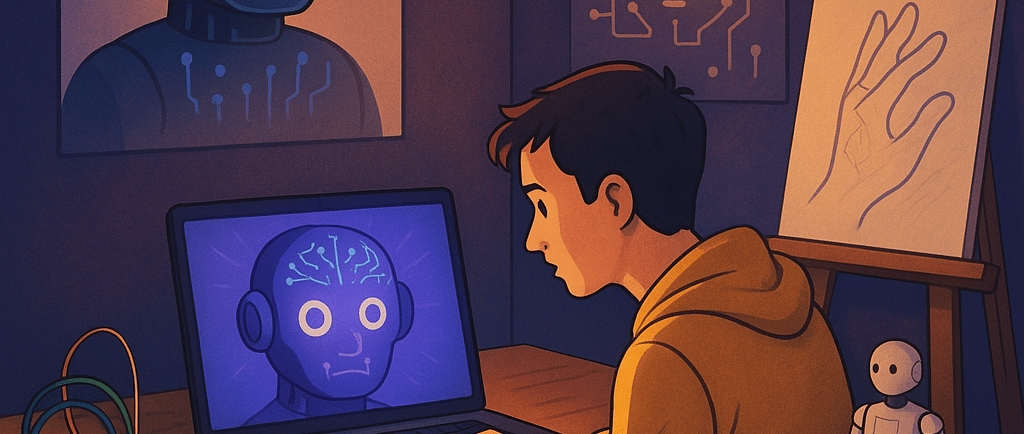
Using AI to teach you
People always assume AI will do it for you, Why don't you let it teach you?
Shane Brown
6/10/20254 min read


Leveraging AI for Tech Learning: A Beginner's Guide to DIY Projects and Skill Development
Artificial intelligence (AI) has completely changed the way people can enter the tech world. These days, you don’t need to be a seasoned programmer to build powerful projects or learn in-demand skills. In fact, AI has opened the doors wide for beginners who want to get their hands dirty with creative DIY projects or develop valuable tech skills—without needing years of experience.
Why AI Is a Game-Changer for Learning
AI can help beginners skip over some of the steepest learning curves in tech. Instead of spending months trying to learn complex programming languages, many AI tools now allow people to interact using simple visuals, plain language, or pre-built templates. These tools can help users build apps, train models, and even automate tasks—all with little to no code.
This shift is making it easier for people from non-technical backgrounds to explore machine learning, automation, and other areas of tech that used to be out of reach. Whether you're a hobbyist, entrepreneur, or student, AI can be your launchpad.
The Rise of No-Code AI Platforms
No-code AI platforms make it possible to build machine learning models using drag-and-drop tools and simple workflows. These platforms handle the heavy lifting—like data preparation, model training, and deployment—so you can focus on the idea and functionality behind your project.
Instead of coding in Python or mastering data science, users can now build and test projects through visual interfaces. This means rapid experimentation, quicker feedback loops, and a better learning experience overall.
Tools That Make AI Easy to Learn
Here are some standout platforms that make AI learning and building more accessible:
Visual AI Tools for Beginners
Teachable Machine by Google – This is one of the best entry-level tools for exploring machine learning. Users can upload pictures and train a model right in the browser. It’s super intuitive and a great way to learn how AI classifies and learns from data.
Lobe by Microsoft – Another excellent tool for image classification. Lobe makes it easy to build, test, and improve models quickly. It gives feedback on accuracy and performance and lets you export your model for use in other systems.
Creative and Visual Platforms
Leonardo AI – A perfect platform for people interested in the creative side of AI. Whether you're generating art, experimenting with prompts, or just having fun, Leonardo offers free daily credits and a user-friendly interface.
Broader Application Builders
Softr – If you’re looking to build a full application (not just an AI model), Softr allows you to create web apps using data from spreadsheets and databases. It’s ideal for anyone wanting to build something functional without needing to code.
Advanced but Accessible Options
Google Cloud AutoML – For those ready to level up, AutoML lets you build custom AI models with the power of Google’s cloud. It’s more complex than beginner tools but still designed to be user-friendly.
Graphite Note – Great for predictive analytics and business decision-making. It's a no-code solution that lets you forecast trends or analyze operations without needing deep technical knowledge.
Easy AI Project Ideas for Beginners
Here are a few project ideas that are simple to start but offer real learning value:
Visual Recognition Projects
Image Classification: Train a model to tell the difference between pets, objects, or moods using Teachable Machine or Lobe.
Hand Gesture Recognition: Use a webcam and AI to identify hand signs for games or accessibility.
Color Detection: Create a tool that identifies colors in images or in real-time through a camera.
Creative AI Projects
AI Art and Prompting: Generate visuals or concept art using Leonardo AI or similar platforms.
Sketch Conversion: Turn photos into sketches with tools like OpenCV combined with a no-code interface.
AI Music Generator: Use simplified tools to create original music based on your inputs.
Practical, Text-Based Projects
Chatbots: Use templates or builders to create an assistant that answers questions or handles tasks.
Sentiment Analysis: Analyze text (like reviews or tweets) and predict whether the tone is positive, negative, or neutral.
Learning Paths and Resources
To build a solid foundation and stay motivated, follow a step-by-step approach:
Phase 1: Learn the Basics (Weeks 1–4)
Start with Andrew Ng’s “AI for Everyone” course.
Play with Teachable Machine to understand how models learn.
Focus on key concepts like datasets, training, and predictions.
Phase 2: Explore Tools (Weeks 5–8)
Try out Lobe for more visual models.
Use Leonardo AI to experiment with creativity.
Learn the AI development cycle from start to finish.
Phase 3: Build Real Projects (Weeks 9–16)
Choose a project idea that excites you.
Use platforms like Graphite Note or Softr.
Learn deployment basics and how to share your work.
Phase 4: Combine and Expand (Weeks 17–24)
Connect tools using platforms like Zapier.
Explore cloud tools like Google AutoML.
Learn about AI ethics, bias, and responsible development.
Common Challenges and How to Beat Them
Technical Hurdles
Poor Data Quality: Start with clean, free datasets from platforms like Kaggle.
Low Model Accuracy: Understand that iteration is normal—adjust data, train again.
Learning Curve
Too Much Jargon: Focus on hands-on tools that teach through doing.
Too Many Tools: Stick with 1–2 platforms early on until you're comfortable.
Project Burnout
Overambitious Starts: Begin with something simple to build momentum.
Hard Integrations: Use platforms with built-in web or app export options.
Where to Go Next
Once you're comfortable, you can transition to code-based development. Python is the go-to language for AI, and libraries like FastAI, TensorFlow, and PyTorch are perfect for beginners ready to level up.
You can also explore:
Computer Vision: Detect objects, faces, or medical images.
Natural Language Processing: Translate text, generate stories, or summarize content.
Cloud AI: Learn how to deploy AI models to real-world environments.
Final Thoughts
AI has made tech learning more approachable than ever. With no-code platforms, easy tutorials, and a thriving community of learners, there’s never been a better time to dive into AI. Whether you're looking to solve real problems, express your creativity, or explore new career paths, AI offers a powerful set of tools for getting started.
Start small, stay curious, and don’t be afraid to make mistakes. Every little project teaches you something new—and before you know it, you’ll be building things you never thought possible.
